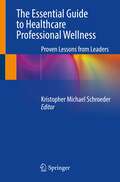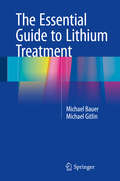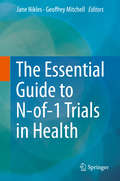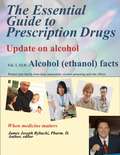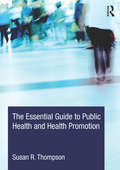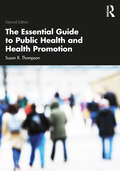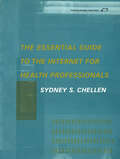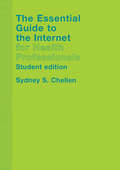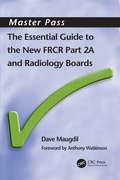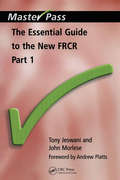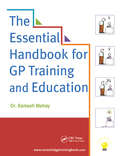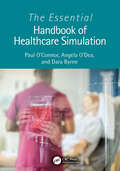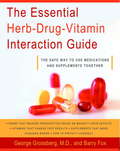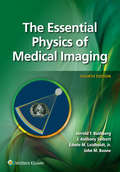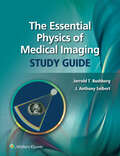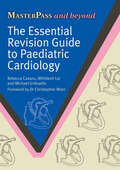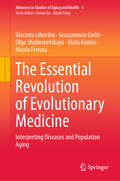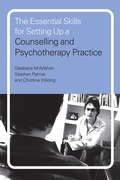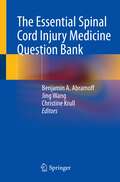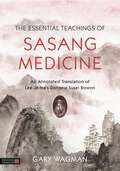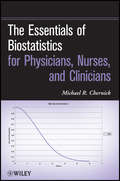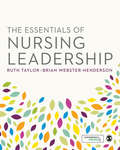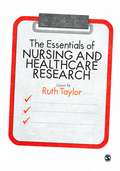- Table View
- List View
The Essential Guide to Healthcare Professional Wellness: Proven Lessons from Leaders
by Kristopher Michael SchroederHealthcare professionals throughout the world heed a calling that compels them to devote their lives to the treatment of their patients. While this work is generally rewarding, these professionals frequently fall victim to stressors and happiness barriers that impact their ability to function at work, the longevity of their career and the quality of their relationships outside of the hospital. Burnout, diminished career fulfilment, substance abuse, and suicide data for healthcare professionals demonstrate that the risks to this population are incredibly real. Unfortunately, there is nothing to suggest that any of these stressors are improving as pandemics, access disparities, changes in healthcare system structure, and patient complexity further escalate work-related challenges. Thankfully, there are sources of help readily available to each of us. All healthcare professionals have encountered a colleague, mentor or expert who has already navigated or has a perspective on how to thrive in the setting of hardship. This book will organize the voices of these leaders in a way that provides readers with a source for advice and inspiration. Sections of chapters are dedicated to work-life balance, family, finances, faith, resiliency, and recovery. For those healthcare workers actively caring for patients and struggling with their career, this book will serve as a source of solace and inspiration that should help to reinvigorate and extend a successful career.
The Essential Guide to Lithium Treatment
by Michael Bauer Michael GitlinThis book is a practical, up-to-date guide to the correct use of lithium for the short- and long-term treatment of mood disorders. Among the subjects addressed are the pharmacology and mechanisms of action of lithium, its use for maintenance treatment, the role of lithium in the treatment of mania and depression and in suicide prevention, further clinical indications, the administration of lithium during pregnancy and the postpartum period, and adverse effects and their management. Relevant background information is provided on the diagnosis, classification, and natural course of mood disorders, and an overview of other treatments for bipolar disorder and major depression is included. Lithium is the essential medication for patients with mood disorders. The evidence of its efficacy in maintenance treatment is acknowledged in all major international treatment guidelines for bipolar disorders and, when used correctly, lithium unquestionably produces the most dramatic benefits of any medication in psychopharmacology. This essential guide is written by two international experts in the treatment of mood disorders who have more than 25 years of experience in the use of lithium and have authored numerous scientific articles on lithium.
The Essential Guide to N-of-1 Trials in Health
by Jane Nikles Geoffrey MitchellN-of-1 trials, a type of individualized randomized controlled trial, are relevant to almost every discipline in medicine and psychology. They can tell the clinician with precision whether a treatment works in that individual, which distinguishes from the information available from most other trial designs. They have the potential to revolutionize the way clinical medicine is practiced. Whether you are a busy clinician, a researcher or a student, this book provides everything you need to know about N-of-1 trials. Written and edited by some of the world's leading experts on N-of-1 trials, the book presents state of the art knowledge about N-of-1 trials, with chapters on ethics, statistics, health economics, design, analysis and reporting, and more. Full of examples and well illustrated, it is a comprehensive compendium of issues surrounding the design, conduct, interpretation and implementation of N-of-1 trials in a health system.
The Essential Guide to Prescription Drugs, Update on Alcohol
by James J Rybacki Pharm. D.The Essential Guide to Prescription Drugs, Update on alcohol is the latest edition of the widely acclaimed family of Essential Guide publications. From potentially life-saving drug interactions to preventing alcohol poisoning, the book is a must read for every family. Find out about key things to talk to your doctor about before drinking, 11 impacts on medicines and health drugs never to combine and even objective web sites to help.
The Essential Guide to Public Health and Health Promotion
by Susan R. ThompsonIn the twenty-first century, public health is everyone’s business. The nursing and medical professions are well placed to provide advice to their clients, especially in respect to lifestyle change, and public health initiatives are supported by a range of statutory and voluntary organisations and health workers, ranging from health promotion specialists to smoking cessation advisers and nutrition assistants. Designed to help readers develop the practical skills they need to become effective public health practitioners, this concise text gives an easily digested overview of public health and health promotion theory in accessible language and diagrams, before moving on to the ways readers can apply this in practice. Providing an opportunity for practitioners to understand possible barriers to lifestyle change, debate health inequalities and responsibilities, and explore the role of the media in changing attitudes, it: Outlines the roles of specific organisations involved in the work of public health work. Covers health needs assessment, agenda setting and the technical aspects of how to research plan and evaluate effective practice either with individual clients or when devising programmes and initiatives for population groups. Details methods of helping people with motivation for lifestyle change, building rapport, ongoing support, monitoring and signposting to specific services. Discusses role of neighbourhoods and communities in improving health and how workers may support local populations to improve the health of their community. The Essential Guide to Public Health and Health Promotion is an accessible introduction to the principles and practice of health promotion and public health for all those new to working or studying in the area, whatever their professional background.
The Essential Guide to Public Health and Health Promotion
by Susan R. ThompsonDesigned to help readers develop the practical skills needed to become effective public health practitioners, this concise text gives a highly accessible overview of the theory and practice of public health and health promotion. The book covers a comprehensive range of key topics, beginning with a discussion of theoretical models and approaches to public health, before addressing important issues such as equality, health education and governmental policy. It also offers readers: Information on health needs assessment, including how to research, plan and evaluate practice with individual clients or population groups. Methods of helping people with motivation for behaviour change, building rapport, ongoing support, and signposting to services. The role of communities in improving health and how to support local populations. In light of the Covid-19 pandemic, this 2nd edition has been updated with new material around vaccination and communicable disease and includes expanded coverage of mental health issues. There’s also a new ‘reflective thinking’ feature to encourage a more critical approach. The Essential Guide to Public Health and Health Promotion, 2nd edition is the ideal starting point for all those new to working or studying in the area, whatever their professional or academic background.
The Essential Guide to Religious Traditions and Spirituality for Health Care Providers
by Jeffers Steven Michael E Nelson Vern Barnet Michael C BranniganThis extraordinary compendium of religious traditions is invaluable to all healthcare providers. The user-friendly resource contains specific and detailed information on faith traditions vital for providing optimal spiritual care in a clinical setting. A series of inspirational introductory chapters promote the importance of spiritual well-being as
The Essential Guide to the Internet for Health Professionals
by Sydney. S. ChellenThere is a wealth of health information on the Internet. Today’s students of health studies and all health care professionals must be able to use this valuable resource and extract from it what is most relevant and useful. In order for them to do this purposefully and skilfully, they need to have a thorough understanding of how the system works and have the ability to navigate their way around it with ease. The Essential Guide to the Internet for Health Professionals is a superb photocopiable resource for lecturers and a self instructional guide for students. It shows students how to: get online; navigate the World Wide Web; find health information on the Internet; communicate with other health professionals; access free health and medical resources; publish on the web; use online help with health studies assignments; search for jobs. Each unit contains easy-to-follow activities and photocopiable worksheets.
The Essential Guide to the Internet for Health Professionals: An Interactive Beginner's Handbook
by Sydney ChellenFirst published in 2003. Routledge is an imprint of Taylor & Francis, an informa company.
The Essential Guide to the New FRCR: Part 2A (MasterPass)
by David MaudgilThis book takes account of recent changes in the Fellowship of the Royal College of Radiologists (FRCR) Part 2A examination. It includes basic radiological science questions as well as the original clinical imaging component, and in particular it discusses cross sectional imaging at an advanced level. Many of these questions are also very useful in preparation for the American Boards Exam in Radiology. Unlike other books in this field, this essential guide provides full explanatory answers and bibliography. Questions are divided into subject chapters corresponding to those in the current FRCR Part 2A syllabus, and structured in an identical fashion to the actual exam.
The Essential Guide to the New FRCR: Pt. 1 (MasterPass)
by Tony Jeswani John MorleseThe focus of the new Fellowship of the Royal College of Radiologists (FRCR) Part 1 exam has shifted to examining the fundamental physics, and radiation protection required to work safely within a radiology department. This book presents the new syllabus in a multiple-choice format that parallels the new exam. In addition, short answer questions reinforce fundamental teaching points. This essential guide will not only enable candidates to sit the exam with confidence, but will help them achieve a better and long lasting understanding of the subject for their future careers.
The Essential Handbook for GP Training and Education
by Ramesh MehayThe much anticipated practical educational manual for General Practice (GP) trainers, programme directors, and other teachers and educators in primary care has finally arrived. This extensive, full-colour guide is written by a select group of hands-on educators who are passionate and knowledgeable. The book captures their wisdom and vast experience in an accessible and practical way. Although it’s aimed at GP training, there are many chapters in this book that are relevant and transferrable to teachers and educators in areas outside of General Practice (and worldwide). We are sure that GP appraisers, Foundation Year trainers and other medical/nursing student educators will find the detailed comprehensive explorations inspirational. Beautifully presented, the chapters cover a wide educational framework employing a variety of presentational methods such as flowcharts, diagrams, conversational pieces, scenarios and anecdotes. Each chapter has a corresponding webpage containing over 300 additional resources - providing practical tools as well as additional reading material. This book was awarded the Royal College of GP’s ‘Paul Freeling Prize’ in 2013 for merititious work in the field of General Practice education. It is also used as the foundation textbook for the Postgraduate Certificate in Medical Education (PGCE) in at least seven UK universities. The Essential Handbook for GP Training and Education adopts a relaxed, personable approach to primary care education that won't leave you with a headache.
The Essential Handbook of Healthcare Simulation
by Paul O'Connor Angela O’Dea Dara ByrneHealthcare simulation is the modern way to educate healthcare providers to achieve high performance and to improve patient safety. It encompasses mannikin based training for teamwork and nontechnical skills, task trainers for procedural skills, simulated participants for communication skills, and virtual/augmented reality simulation. Based on an award-winning postgraduate course, this text provides the background knowledge required to: run a healthcare simulation centre; use simulation for training and education; and support simulation-based quality improvement and research activities.*Presents a focused and highly practical approach to course material *Offers a detailed guide for anyone who uses healthcare simulation for education, quality improvement, or research *Shows a practical focus for teaching, quality improvement, and research
The Essential Herb-Drug-Vitamin Interaction Guide
by Barry Fox George T. GrossbergIF YOU DON’T KNOW THE POSSIBLE SIDE EFFECTS OF MIXING HERBS, DRUGS, AND VITAMINS, YOU’RE PUTTING YOURSELF AT RISK. Did you know that . . . Using echinacea to ward off a cold while you’re taking Tylenol can severely damage your liver? Mixing kava kava and alcohol can be toxic? If you’re diabetic and you take Panax ginseng, you can dangerously lower your blood sugar levels? Drinking green tea can lead to false-positive results for some forms of cancer? Taking St. John’s wort while you’re on birth control, prescription antidepressants, or certain heart medications can be deadly? These are just a few of the warnings you need to know. If you’re one of the 60 million herb, vitamin, and supplement users in America, you need to know how to use herbs and supplements safely and effectively. The Essential Herb-Drug-Vitamin Interaction Guideprofiles 300 supplements and gives vital information regarding potentially dangerous interactions, possible side effects, and typical dosages. Written by a leading authority in the field and a veteran health writer,The Essential Herb-Drug-Vitamin Interaction Guideis organized alphabetically by herb, with an index of medications at the end of the book so you can instantly locate the information you need, Comprehensive, thoroughly researched, and easy to use, this is one health guide you can’t afford to be without.
The Essential Physics of Medical Imaging
by Jerold T. Bushberg J. Anthony Seiberg Edwin M. Leidholdt Jr. John M. BooneWidely regarded as the cornerstone text in the field, the successful series of editions continues to follow the tradition of a clear and comprehensive presentation of the physical principles and operational aspects of medical imaging. The Essential Physics of Medical Imaging, 4th Edition, is a coherent and thorough compendium of the fundamental principles of the physics, radiation protection, and radiation biology that underlie the practice and profession of medical imaging. Distinguished scientists and educators from the University of California, Davis, provide up-to-date, readable information on the production, characteristics, and interactions of non-ionizing and ionizing radiation, magnetic fields and ultrasound used in medical imaging and the imaging modalities in which they are used, including radiography, mammography, fluoroscopy, computed tomography, magnetic resonance, ultrasound, and nuclear medicine. This vibrant, full-color text is enhanced by more than 1,000 images, charts, and graphs, including hundreds of new illustrations. This text is a must-have resource for medical imaging professionals, radiology residents who are preparing for Core Exams, and teachers and students in medical physics and biomedical engineering.
The Essential Physics of Medical Imaging Study Guide
by Jerrold T. Bushberg J. Anthony SeibertWidely regarded as the cornerstone text in the field, the successful series of editions continues to follow the tradition of a clear and comprehensive presentation of the physical principles and operational aspects of medical imaging. The Essential Physics of Medical Imaging, 4th Edition, is a coherent and thorough compendium of the fundamental principles of the physics, radiation protection, and radiation biology that underlie the practice and profession of medical imaging. Distinguished scientists and educators from the University of California, Davis, provide up-to-date, readable information on the production, characteristics, and interactions of non-ionizing and ionizing radiation, magnetic fields and ultrasound used in medical imaging and the imaging modalities in which they are used, including radiography, mammography, fluoroscopy, computed tomography, magnetic resonance, ultrasound, and nuclear medicine. This vibrant, full-color text is enhanced by more than 1,000 images, charts, and graphs, including hundreds of new illustrations. This text is a must-have resource for medical imaging professionals, radiology residents who are preparing for Core Exams, and teachers and students in medical physics and biomedical engineering.
The Essential Revision Guide to Paediatric Cardiology (MasterPass)
by Rebecca Casans Mithilish Lal Michael GriksaitisA unique reference book covering the relevant basic sciences of cardiac anatomy, physiology and pharmacology through to the initial clinical assessment and investigation. It covers the core curricula for paediatricians in training at all levels including the MRCPCH and DCH examinations. This book is relevant to paediatricians in training, general practitioners, emergency department staff and specialist nurses. General staff working in specialist regional cardiac centres and healthcare professionals involved in the care of children and young people will also find this essential resource extremely useful. 'The aim of this handbook is to provide a rapid and reliable reference to congenital and acquired cardiac problems. It is very well organised. provides a more detailed discussion of cardiac physiology and pathophysiology and a comprehensive guide to ECG interpretation. It should be of particular interest to paediatricians in training, including those studying for higher professional examinations, but it also provides a valuable source of reference for paediatricians already in practice.' From the Foreword by Dr Christopher Wren
The Essential Revolution of Evolutionary Medicine: Interpreting Diseases and Population Aging (Advances in Studies of Aging and Health #4)
by Giacinto Libertini Graziamaria Corbi Olga Shubernetskaya Nicola Ferrara Klara KomiciThis book proposes a way to radically renew medicine by extending to medicine the concepts of evolutionary biology. The book considers diseases not as unpredictable harmful events but as logical consequences of evolutionary mechanisms. In particular, a large part of the most widespread diseases that afflict modern populations are interpreted as the consequence of discordances (mismatches) between new living conditions and the adaptation of our species. It discusses the basic concepts, as well as diseases deriving from alterations of the genotype and general concepts about diseases deriving from alterations of the ecological niche. It also describes diseases deriving from relations with other living beings especially when the ecological niche is altered, diseases deriving from conditions beyond the adaptation range, and physiological phenomena that cause troubles and suffering or even death. A particular study is dedicated to the interpretation of aging and its consequences in normal or altered conditions of the ecological niche. The final part of the book describes the implementation of evolutionary medicine. This book, complementing the "Evolutionary Gerontology and Geriatrics" book, which is also published in this series, provides a valuable read for scholars and students in the fields of medicine, evolutionary biology, preventive medicine, and gerontology.
The Essential Skills for Setting Up a Counselling and Psychotherapy Practice
by Christine Wilding Stephen Palmer Gladeana McMahonMany practitioners consider setting up in private practice at some point in their career, whether full-time or alongside other employment. The Essential Skills for Setting Up a Counselling and Psychotherapy Practice provides comprehensive yet accessible coverage of all the major skills needed to succeed. Based on the authors' extensive experience, this book provides a valuable insight into how to minimise the risks associated with working privately, offering practical advice on how to keep a balance between self-development, personal health and meeting the needs of clients, whilst maintaining high standards and making a reasonable living. Acknowledging the fact that being a good therapist may not, in itself, be sufficient to be successful in self-employment, the authors discuss the need for sound business skills, professional development, self-knowledge and motivation. Divided into three sections, the book covers all the essential business, professional and personal skills and includes discussion of subjects such as insurance, finance, legal issues, marketing, stress management, security and retirement planning. The focus on skills and how to acquire and develop them makes this book an invaluable reference for all mental health professionals who are considering setting up their own private practice. This book will prove to be an invaluable reference for all mental health professionals who are considering setting up their own private practice.
The Essential Spinal Cord Injury Medicine Question Bank
by Jing Wang Benjamin A. Abramoff Christine KrullThis text serves as a high-yield review of spinal cord injury medicine in a multiple choice question-based format. The content covered reflects key topics relevant to clinical practice and subspecialty certification through the American Board of Physical Medicine and Rehabilitation (ABPMR) Spinal Cord Injury (SCI) Medicine examination. The 22 chapters are arranged topically to address the full scope of information relevant to the field of spinal cord injury medicine. Included with each question is a corresponding in-depth explanation, as well as pertinent references to supporting literature. The questions and educational explanations are written by leading experts in the field of spinal cord injury medicine and are designed to be board-relevant in both content and style. This question bank should be of use to anyone wishing to test and expand their knowledge of spinal cord injury medicine, including therapists, medical students, residents, fellows, and attending physicians of any specialty.
The Essential Teachings of Sasang Medicine: An Annotated Translation of Lee Je-ma's Dongeui Susei Bowon
by Gary WagmanSasang Medicine, the only complete Korean medical system and philosophy, is made accessible in English for the first time through this annotated translation of Lee Je-ma's foundational text, the Dongeui Susei Bowon. Including a philosophical exploration of human emotions and constitutions, and comprehensive explanation of the Four Constitutions and their effects on health, the Dongeui Susei Bowon offers a unique approach to any health concern. It also includes examples of specific cases and how to apply over one hundred herbal formulae for effective treatment according to the energetic requirements of each Sasang constitution. Rigorous translation, explanatory introduction explaining the relationship to and differences from Chinese medicine, detailed footnotes, and commentary by a practicing doctor of Korean medicine fully elucidates Lee Je-ma's text for a thorough understanding of Sasang Medicine.
The Essentials of Biostatistics for Physicians, Nurses, and Clinicians
by Michael R. ChernickA fundamental and straightforward guide to using and understanding statistical concepts in medical researchDesigned specifically for healthcare practitioners who need to understand basic biostatistics but do not have much time to spare, The Essentials of Biostatistics for Physicians, Nurses and Clinicians presents important statistical methods used in today's biomedical research and provides insight on their appropriate application. Rather than provide detailed mathematics for each of these methods, the book emphasizes what healthcare practitioners need to know to interpret and incorporate the latest biomedical research into their practices.The author draws from his own experience developing and teaching biostatistics courses for physicians and nurses, offering a presentation that is non-technical and accessible. The book begins with a basic introduction to the relationship between biostatistics and medical research, asking the question "why study statistics?," while also exploring the significance of statisitcal methods in medical literature and clinical trials research. Subsequent chapters explore key topics, including:Correlation, regression, and logistic regressionDiagnosticsEstimating means and proportionsNormal distribution and the central limit theoremSampling from populationsContingency tablesMeta-analysisNonparametric methodsSurvival analysisThroughout the book, statistical methods that are often utilized in biomedical research are outlined, including repeated measures analysis of variance, hazard ratios, contingency tables, log rank tests, bioequivalence, cross-over designs, selection bias, and group sequential methods. Exercise sets at the end of each chapter allow readers to test their comprehension of the presented concepts and techniques.The Essentials of Biostatistics for Physicians, Nurses, and Clinicians is an excellent reference for doctors, nurses, and other practicing clinicians in the fields of medicine, public health, pharmacy, and the life sciences who need to understand and apply statistical methods in their everyday work. It also serves as a suitable supplement for courses on biostatistics at the upper-undergraduate and graduate levels.
The Essentials of Nursing Leadership
by Ruth Taylor Brian Webster-HendersonThis new approach to leadership focuses on how students can develop leadership skills right from the start of their nursing programme through to transitioning to their first role. The book first takes students through the underpinning knowledge and theory and then through practical skills to help them understand all aspects of leadership and how it is a key component of providing quality care to patients in a range of environments and settings. Real stories from nursing leaders, practitioners and students are included to inspire students and show them how they can impact positively on practice, whatever level they are working at. Key features include: Real life focus, grounded in everyday practice, with lots of case studies and examples to help students see how theory relates to practice Activities to help students reflect about their own practice, and about themselves as leaders Video interviews with nurse leaders and students on the companion website Further reading and links to journal articles in both the book and the companion website help students delve deeper and prepare for assessments.
The Essentials of Nursing Leadership
by Ruth Taylor Brian Webster-HendersonThis new approach to leadership focuses on how students can develop leadership skills right from the start of their nursing programme through to transitioning to their first role. The book first takes students through the underpinning knowledge and theory and then through practical skills to help them understand all aspects of leadership and how it is a key component of providing quality care to patients in a range of environments and settings. Real stories from nursing leaders, practitioners and students are included to inspire students and show them how they can impact positively on practice, whatever level they are working at. Key features include: Real life focus, grounded in everyday practice, with lots of case studies and examples to help students see how theory relates to practice Activities to help students reflect about their own practice, and about themselves as leaders Video interviews with nurse leaders and students on the companion website Further reading and links to journal articles in both the book and the companion website help students delve deeper and prepare for assessments.
The Essentials of Nursing and Healthcare Research
by Prof Ruth TaylorFor some students, research can be a daunting and intimidating topic when beginning your degree. This lively book helps you understand why research is important, gives a straightforward account of the essential knowledge that you will need and demystifies the language and process of research. It focuses on the skills you will use throughout your degree, and how research and evidence can make a difference to the world you will encounter in practice. It outlines: · What research is · Qualitative and quantitative approaches · The practicalities of doing research · Using evidence in practice. The chapters are full of practical tools and draw on a range of student experiences, making it the perfect textbook for undergraduates. Ruth Taylor is a Professor of Nursing and Deputy Dean at Anglia Ruskin University.
